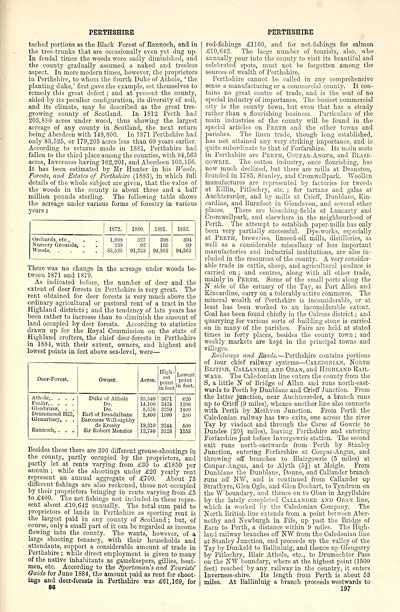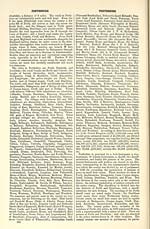Ordnance gazetteer of Scotland > Volume 5
(291) Page 197
Download files
Complete book:
Individual page:
Thumbnail gallery: Grid view | List view

PERTHSHIRE
tached portions as the Black Forest of Rannoch, and in
the tree-trunks that are occasionally even yet dug up.
In feudal times the woods were sadly diminished, and
the county gradually assumed a naked and treeless
aspect. In more modern times, however, the proprietors
in Perthshire, to whom the fourth Duke of Athole, ' the
planting duke,' first gave the example, set themselves to
remedy this great defect ; and at present the county,
aided by its peculiar configuration, its diversity of soil,
and its climate, may be described as the great tree-
growing county of Scotland. In 1812 Perth had
203,880 acres under wood, thus showing the largest
acreage of any county in Scotland, the next return
being Aberdeen with 148,800. In 1871 Perthshire had
only 83,525, or 179,205 acres less than 60 years earlier.
According to returns made in 1881, Perthshire had
fallen to the third place among the counties, with 94,563
acres, Inverness having 162,201, and Aberdeen 103,156.
It has been estimated by Mr Hunter in his Woods,
Forests, and Estates of Pertlishire (1883), in which full
details of the whole subject are given, that the value of
the woods in the county is about three and a half
million pounds sterling. The following table shows
the acreage under various forms of forestry in various
years :
1872. 1880.
1881.
18S2.
Orchards, etc.,
Nursery Grounds, .
Woods, ....
1,098 i 327
239 92
83,525 91,333
398
105
94,563
394
99
94,563
There was no change in the acreage under woods be-
tween 1871 and 1879.
As indicated before, the number of deer and the
extent of deer forests in Perthshire is very great. The
rent obtained for deer forests is very much above the
ordinary agricultural or pastoral rent of a tract in the
Highland districts ; and the tendency of late years has
been rather to increase than to diminish the amount of
land occupied by deer forests. According to statistics
drawn up for the Royal Commission on the state of
Highland crofters, the chief deer-forests in Perthshire
in 1884, with their extent, owners, and highest and
lowest points in feet above sea-level, were —
Deer-Forest.
Owner.
Acres.
High-
est
point
in feet
Lowest
point
in feet.
Athole,. . . .
Fealar, ....
Gleubruar, . .
Drummond Hill,
Glenartney, . .
JRannocb, . , ,
Duke of Athole
Do.
Do,
Earl of Breadalbane
Baroness Willoughby
de Eresby
Sir Robert Menzies
36,640
14,100
8,670
2,400
19,310
12,740
3671
3424
3260
1500
3244
3128
620
1200
1400
380
600
1153
Besides these there are 390 different grouse-shootings in
the county, partly occupied by the proprietors, and
partly let at rents varying from £30 to £1850 per
annum ; while the shootings under £20 yearly rent
represent an annual aggregate of £700. About 73
different fishings are also reckoned, those not occupied
by their proprietors bringing in rents varying from £5
to £400. The net fishiugs not included in these repre-
sent about £10,642 annually. The total sum paid to
proprietors of lands in Perthshire as sporting rent is
the largest paid in any county of Scotland ; but, of
course, only a small part of it can he regarded as income
flowing into the county. The wants, however, of a
large shooting tenancy, with their households and
attendants, support a considerable amount of trade in
Perthshire ; while direct employment is given to many
of the native inhabitants as gamekeepers, gillies, boat-
men, etc. According to the Sportsman's and Tourists'
Guide for June 1884, the amount paid as rent for shoot-
ings and deer-forests in Perthshire was £61,169, for
86
PERTHSHIRE
rod-fishings £1160, and for net-fishings for salmon
£10,642. The large number of tourists, also, who
annually pour into the county to visit its beautiful and
celebrated spots, must not be forgotten among the
sources of wealth of Perthshire.
Perthshire cannot be called in any comprehensive
sense a manufacturing or a commercial county. It con-
tains no great centre of trade, and is the seat of no
special industry of importance. The busiest commercial
city is the county town, but even that has a steady
rather than a flourishing business. Particulars of the
main industries of the county will be found in the
special articles on Perth and the other towns and
parishes. The linen trade, though long established,
has not attained any very striking importance, and is
quite subordinate to that of Forfarshire. Its main seats
in Perthshire are Perth, Coitpak-Angus, and Blair-
gowrie. The cotton industry, once flourishing, has
now much declined, but there are mills at Deanston,
founded in 1785, Stanley, and Cromwellpark. Woollen
manufactures are represented by factories for tweeds
at Killin, Pitlochry, etc. ; for tartans and galas at
Auchterarder, and by mills at Criefi', Dunblane, Kin-
cardine, and Burnfoot in Glendevon, and several other
places. There are bleaching-fields at Luncarty and
Cromwellpark, and elsewhere in the neighbourhood of
Perth. The attempt to establish paper-mills has only
been very partially successful. Dye-works, especially
at Perth, breweries, linseed-oil mills, distilleries, as
well as a considerable miscellany of less important
manufactories and industrial institutions, are also in-
cluded in the resources of the county. A very consider-
able trade in cattle, sheep, and agricultural produce is
carried on ; and centres, along with all other trade,
mainly in Perth. Some of the small ports along the
N side of the estuary of the Tay, as Port AUen and
Kincardine, carry on a tolerably active commerce. The
mineral wealth of Perthshire is inconsiderable, or at
least has been worked to an inconsiderable extent.
Coal has been found chiefly in the Culross district ; and
quarrying for various sorts of building stone is carried
on in many of the parishes. Fairs are held at stated
times in forty places, besides the county town ; and
weekly markets are kept in the principal towns and
villages.
Railways and Boads. — Perthshire contains portions
of four chief railway systems — Caledoniak, North
British, Caliander and Oban, and Highland Rail-
ways. The Caledonian line enters the county from the
S, a little N of Bridge of Allan, and runs north-east-
wards to Perth by Dimblane and Crieff Junction. From
the latter junction, near Auchterarder, a branch runs
up to Criefi' (9 mOes), whence another line also connects
with Perth by Methven Junction. From Perth the
Caledonian railway has two exits, one across the river
Tay by viaduct and through the Carse of Cowrie to
Dundee (20J miles), leaving Perthshire and entering
Forfarshire just before Invergowrie station. The second
exit runs north-eastwards from Perth by Stanley
Junction, entering Forfarshire at Coupar-Angus, and
throwing off branches to Blairgowrie (5 miles) at
Coupar-Angus, and to Alyth (5J) at Meigle. From
Dunblane the Dunblane, Doune, and Callander branch
runs off NW, and is contiuued from Callander up
Strathyre, Glen Ogle, and Glen Dochart, to Tyndrum on
the W boundary, and thence on to Oban in Argyllshire
by the lately completed Callander and Oban line,
which is worked by the Caledonian Company. The
North British line extends from a point between Aber-
nethy and Newburgh in Fife, up past the Bridge of
Earn to Perth, a distance within 9 miles. The High-
land railway branches off NW from the Caledonian line
at Stanley Jimction, and proceeds up the valley of the
Tay by Dimkeld to Ballinluig, and thence up Glengarry
by Pitlochry, Blair Athole, etc, to Drumochter Pass
on the NW boundary, where at the highest point (1500
feet) reached by any railway in the coimtry, it enters
Inverness-shire, Its length from Perth is about 53
mUes. At Ballinluig a branch proceeds westwards to
197
tached portions as the Black Forest of Rannoch, and in
the tree-trunks that are occasionally even yet dug up.
In feudal times the woods were sadly diminished, and
the county gradually assumed a naked and treeless
aspect. In more modern times, however, the proprietors
in Perthshire, to whom the fourth Duke of Athole, ' the
planting duke,' first gave the example, set themselves to
remedy this great defect ; and at present the county,
aided by its peculiar configuration, its diversity of soil,
and its climate, may be described as the great tree-
growing county of Scotland. In 1812 Perth had
203,880 acres under wood, thus showing the largest
acreage of any county in Scotland, the next return
being Aberdeen with 148,800. In 1871 Perthshire had
only 83,525, or 179,205 acres less than 60 years earlier.
According to returns made in 1881, Perthshire had
fallen to the third place among the counties, with 94,563
acres, Inverness having 162,201, and Aberdeen 103,156.
It has been estimated by Mr Hunter in his Woods,
Forests, and Estates of Pertlishire (1883), in which full
details of the whole subject are given, that the value of
the woods in the county is about three and a half
million pounds sterling. The following table shows
the acreage under various forms of forestry in various
years :
1872. 1880.
1881.
18S2.
Orchards, etc.,
Nursery Grounds, .
Woods, ....
1,098 i 327
239 92
83,525 91,333
398
105
94,563
394
99
94,563
There was no change in the acreage under woods be-
tween 1871 and 1879.
As indicated before, the number of deer and the
extent of deer forests in Perthshire is very great. The
rent obtained for deer forests is very much above the
ordinary agricultural or pastoral rent of a tract in the
Highland districts ; and the tendency of late years has
been rather to increase than to diminish the amount of
land occupied by deer forests. According to statistics
drawn up for the Royal Commission on the state of
Highland crofters, the chief deer-forests in Perthshire
in 1884, with their extent, owners, and highest and
lowest points in feet above sea-level, were —
Deer-Forest.
Owner.
Acres.
High-
est
point
in feet
Lowest
point
in feet.
Athole,. . . .
Fealar, ....
Gleubruar, . .
Drummond Hill,
Glenartney, . .
JRannocb, . , ,
Duke of Athole
Do.
Do,
Earl of Breadalbane
Baroness Willoughby
de Eresby
Sir Robert Menzies
36,640
14,100
8,670
2,400
19,310
12,740
3671
3424
3260
1500
3244
3128
620
1200
1400
380
600
1153
Besides these there are 390 different grouse-shootings in
the county, partly occupied by the proprietors, and
partly let at rents varying from £30 to £1850 per
annum ; while the shootings under £20 yearly rent
represent an annual aggregate of £700. About 73
different fishings are also reckoned, those not occupied
by their proprietors bringing in rents varying from £5
to £400. The net fishiugs not included in these repre-
sent about £10,642 annually. The total sum paid to
proprietors of lands in Perthshire as sporting rent is
the largest paid in any county of Scotland ; but, of
course, only a small part of it can he regarded as income
flowing into the county. The wants, however, of a
large shooting tenancy, with their households and
attendants, support a considerable amount of trade in
Perthshire ; while direct employment is given to many
of the native inhabitants as gamekeepers, gillies, boat-
men, etc. According to the Sportsman's and Tourists'
Guide for June 1884, the amount paid as rent for shoot-
ings and deer-forests in Perthshire was £61,169, for
86
PERTHSHIRE
rod-fishings £1160, and for net-fishings for salmon
£10,642. The large number of tourists, also, who
annually pour into the county to visit its beautiful and
celebrated spots, must not be forgotten among the
sources of wealth of Perthshire.
Perthshire cannot be called in any comprehensive
sense a manufacturing or a commercial county. It con-
tains no great centre of trade, and is the seat of no
special industry of importance. The busiest commercial
city is the county town, but even that has a steady
rather than a flourishing business. Particulars of the
main industries of the county will be found in the
special articles on Perth and the other towns and
parishes. The linen trade, though long established,
has not attained any very striking importance, and is
quite subordinate to that of Forfarshire. Its main seats
in Perthshire are Perth, Coitpak-Angus, and Blair-
gowrie. The cotton industry, once flourishing, has
now much declined, but there are mills at Deanston,
founded in 1785, Stanley, and Cromwellpark. Woollen
manufactures are represented by factories for tweeds
at Killin, Pitlochry, etc. ; for tartans and galas at
Auchterarder, and by mills at Criefi', Dunblane, Kin-
cardine, and Burnfoot in Glendevon, and several other
places. There are bleaching-fields at Luncarty and
Cromwellpark, and elsewhere in the neighbourhood of
Perth. The attempt to establish paper-mills has only
been very partially successful. Dye-works, especially
at Perth, breweries, linseed-oil mills, distilleries, as
well as a considerable miscellany of less important
manufactories and industrial institutions, are also in-
cluded in the resources of the county. A very consider-
able trade in cattle, sheep, and agricultural produce is
carried on ; and centres, along with all other trade,
mainly in Perth. Some of the small ports along the
N side of the estuary of the Tay, as Port AUen and
Kincardine, carry on a tolerably active commerce. The
mineral wealth of Perthshire is inconsiderable, or at
least has been worked to an inconsiderable extent.
Coal has been found chiefly in the Culross district ; and
quarrying for various sorts of building stone is carried
on in many of the parishes. Fairs are held at stated
times in forty places, besides the county town ; and
weekly markets are kept in the principal towns and
villages.
Railways and Boads. — Perthshire contains portions
of four chief railway systems — Caledoniak, North
British, Caliander and Oban, and Highland Rail-
ways. The Caledonian line enters the county from the
S, a little N of Bridge of Allan, and runs north-east-
wards to Perth by Dimblane and Crieff Junction. From
the latter junction, near Auchterarder, a branch runs
up to Criefi' (9 mOes), whence another line also connects
with Perth by Methven Junction. From Perth the
Caledonian railway has two exits, one across the river
Tay by viaduct and through the Carse of Cowrie to
Dundee (20J miles), leaving Perthshire and entering
Forfarshire just before Invergowrie station. The second
exit runs north-eastwards from Perth by Stanley
Junction, entering Forfarshire at Coupar-Angus, and
throwing off branches to Blairgowrie (5 miles) at
Coupar-Angus, and to Alyth (5J) at Meigle. From
Dunblane the Dunblane, Doune, and Callander branch
runs off NW, and is contiuued from Callander up
Strathyre, Glen Ogle, and Glen Dochart, to Tyndrum on
the W boundary, and thence on to Oban in Argyllshire
by the lately completed Callander and Oban line,
which is worked by the Caledonian Company. The
North British line extends from a point between Aber-
nethy and Newburgh in Fife, up past the Bridge of
Earn to Perth, a distance within 9 miles. The High-
land railway branches off NW from the Caledonian line
at Stanley Jimction, and proceeds up the valley of the
Tay by Dimkeld to Ballinluig, and thence up Glengarry
by Pitlochry, Blair Athole, etc, to Drumochter Pass
on the NW boundary, where at the highest point (1500
feet) reached by any railway in the coimtry, it enters
Inverness-shire, Its length from Perth is about 53
mUes. At Ballinluig a branch proceeds westwards to
197
Set display mode to: Large image | Transcription
Images and transcriptions on this page, including medium image downloads, may be used under the Creative Commons Attribution 4.0 International Licence unless otherwise stated. ![]()
| Gazetteers of Scotland, 1803-1901 > Ordnance gazetteer of Scotland > Volume 5 > (291) Page 197 |
|---|
| Permanent URL | https://digital.nls.uk/97387442 |
|---|
| Attribution and copyright: |
|
|---|---|

